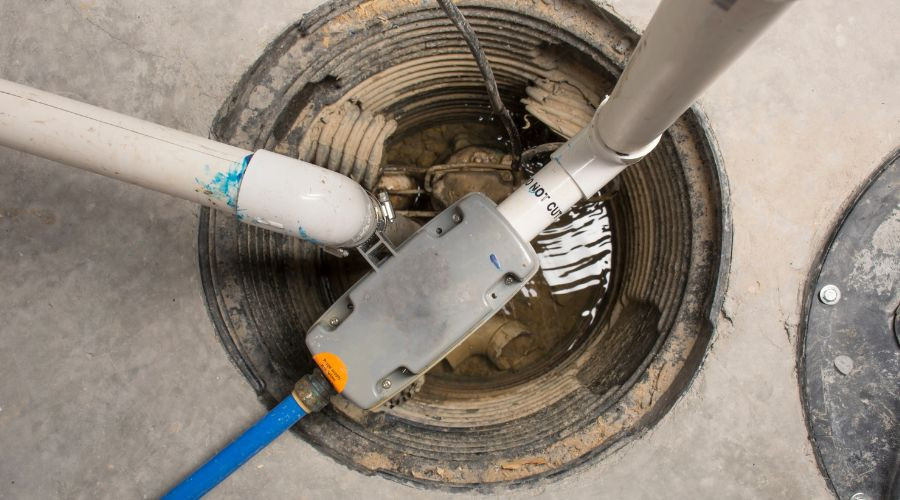What Is a Sump Pump?
A sump pump is a vital device that helps protect homes from the risks of water damage and basement flooding. Installing a sump pump is an effective way to safeguard a home against flooding and water damage. For homeowners tired of worrying about costly repairs caused by rising water, a sump pump offers fast, reliable protection. It not only prevents flood-related damage but also provides long-term savings and peace of mind. This blog post will discuss types of sump pumps and the benefits of sump pump installation.
Benefits of Sump Pumps
 Sump pumps act as the first line of defense against basement flooding and water damage. These mechanical devices automatically activate when water levels rise in the sump pit, pumping excess groundwater away from the foundation to prevent flooding. Sump pumps operate continuously during heavy rainfall or snowmelt, which often causes water to find the lowest point, typically the basement.
Sump pumps act as the first line of defense against basement flooding and water damage. These mechanical devices automatically activate when water levels rise in the sump pit, pumping excess groundwater away from the foundation to prevent flooding. Sump pumps operate continuously during heavy rainfall or snowmelt, which often causes water to find the lowest point, typically the basement.
During periods of heavy precipitation, groundwater pressure increases around the foundation, forcing water through cracks and seams. A properly installed sump pump intercepts this water before it enters the living space, redirecting it safely away from the property. Many homeowners find that the cost of a flooded basement and its repairs is far greater than the initial investment in a sump pump.
The benefits of installing a sump pump go beyond basic flood protection. These systems also help reduce basement humidity levels, preventing mold growth and protecting the structural integrity of the home. Additionally, a dry basement improves indoor air quality throughout the house. According to the American Society of Home Inspectors, over 60% of American homes experience below-ground wetness or flooding. Preventing basement water damage is one of the top reasons homeowners maintain higher property values when selling their homes.
Primary Types of Sump Pumps
When installing a sump pump, homeowners typically choose between submersible and pedestal models. Each type offers distinct advantages, depending on the specific waterproofing needs and budget considerations of the home.
Submersible sump pumps are designed to sit completely underwater in the sump pit. They operate quietly and efficiently, offering superior pumping power. This makes them ideal for homes in flood-prone areas that experience heavy water intrusion. Submersible models can pump more gallons per hour than pedestal models.
However, this increased performance comes with a higher price tag—submersible pumps are typically 30-50% more expensive than pedestal pumps and have a shorter lifespan due to constant exposure to water. Despite the higher initial cost, many homeowners prefer submersible pumps for their quiet operation and discreet installation.
Pedestal sump pumps, on the other hand, have their motor positioned above the water level, with only the pump base submerged. This design significantly extends their lifespan, often reaching 25-30 years with proper maintenance. Pedestal pumps are also easier to access for repairs and maintenance checks. While they produce more noise and occupy more visible space in the basement, pedestal pumps remain a more affordable option for homes with moderate flooding risks. Their lower horsepower ratings are usually sufficient for managing typical water seepage, offering a more budget-friendly solution.
Secondary or Backup Sump Pumps
 In addition to a primary sump pump, homeowners should consider installing a secondary sump pump backup for comprehensive flood protection. Primary pumps can fail during severe weather events, precisely when protection is needed most. Power outages, which frequently accompany major storms, can render electric pumps useless. Without a backup system, a home remains vulnerable.
In addition to a primary sump pump, homeowners should consider installing a secondary sump pump backup for comprehensive flood protection. Primary pumps can fail during severe weather events, precisely when protection is needed most. Power outages, which frequently accompany major storms, can render electric pumps useless. Without a backup system, a home remains vulnerable.
A battery-powered backup sump pump is a critical safety measure during power outages. These systems automatically activate when the primary pump loses power or cannot keep up with water infiltration. Battery backups can run continuously for 7-10 hours, depending on water volume and battery capacity. Homes equipped with backup pump systems have 85% fewer flood-related insurance claims during major weather events, according to the American Society of Home Inspectors. Investing in prevention helps avoid costly cleanup and long-term damage.
In addition to power outages, mechanical failures pose another significant risk to sump pump systems. Primary pumps can burn out, malfunction, or become clogged with debris. Alternatively, water-powered backup pumps use municipal water pressure instead of electricity or batteries, providing virtually unlimited runtime during emergencies. These systems operate through the Venturi effect, creating suction to remove water. However, they do increase water utility usage while active. Regardless of the backup type, having a secondary pump ensures peace of mind when flooding threatens a home’s foundation and belongings.
By understanding the importance of sump pumps and their benefits, homeowners can make an informed decision to protect their property. Whether opting for a primary sump pump or a backup system, taking the necessary precautions can help keep a home safe and dry during times of heavy rain, snowmelt, and rising groundwater.
About Walker Plumbing, Heating & Air
Walker Plumbing, Heating & Air is a reliable plumbing, heating, and AC contractor serving Washington, UT, and the surrounding areas. They offer straightforward pricing, same-day service, and 24/7 live answers. Call them for sump pump installation and services in Washington, UT.



